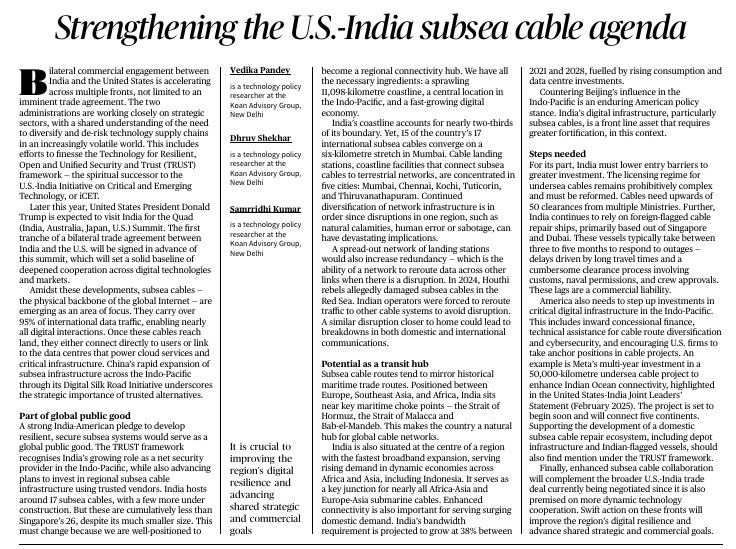1. Central Theme
- Importance of subsea cable infrastructure for U.S.-India digital cooperation.
- Geostrategic and economic imperatives for secure, diversified, and resilient digital connectivity.
- Subsea cables as a new frontier in critical technology and supply chain security.
- Contextual Background
- S.-India working on a bilateral digital trade agreement, aligned with the Quad and TRUST framework.
- Shared interest in securing digital supply chains and reducing dependence on China.
- Subsea cables carry ~95% of international internet traffic and are now emerging as strategic assets.
3. Strategic Importance of Subsea Cables
- Physical backbone of the global internet.
- Link data centers, cloud services, and digital markets across countries.
- Directly linked to national security, economic growth, and digital sovereignty.
- China’s presence in Indo-Pacific subsea infrastructure (e.g., Peace Cable, Huawei Marine) raises geopolitical risks.
4. India’s Domestic Challenge
- Unequal cable landing concentration – 5 cities (Mumbai, Chennai, Kochi, Tuticorin, Thiruvananthapuram) handle majority.
- Vulnerability to natural disasters, sabotage, or blockades in one region.
- Bureaucratic delays – ~50 clearances from multiple ministries for new cable landings.
- Overdependence on foreign repair hubs (Singapore, Dubai) → leads to delays and revenue losses.
- Recent Threats & Examples
- Houthi attacks (2024) in the Red Sea damaged subsea cables → forced rerouting of Indian operators.
- India’s repair capacity is limited → needs redundancy and regional resilience.
- Example: Meta’s new subsea cable in East Africa; Google’s “Echo” system to bypass congested Asian routes.
6. Proposed U.S.-India Action Plan
- Joint development of new diversified cable routes across the Indo-Pacific.
- Shared investment in Indian data centers and domestic cable repair infrastructure.
- Simplify clearance processes and create a single-window system for approvals.
7. Steps Needed (Policy Recommendations)
- Liberalize licensing norms for cable landings.
- Create redundant routes across east and west coasts.
- Invest in in-country repair capabilities.
- Frame a subsea cable strategy aligned with national cyber and tech policy.
- Align with trusted partner frameworks like the Quad or G7 Digital Gateway.
8. Governance & Strategic Keywords
- Digital infrastructure sovereignty
- Trusted networks
- Geo-digital diplomacy
- Resilient supply chains
- Cyber-physical infrastructure
- Undersea digital corridors
- Data localization and cloud architecture
- Bureaucratic harmonization
9. Summary Takeaways
- Subsea cables are now critical infrastructure, not just telecom utilities.
- India must view them through the lens of national security and strategic autonomy.
- S.-India cooperation in this space can help counterbalance China and safeguard digital connectivity in the Indo-Pacific.
GS Paper II – International Relations / Bilateral Cooperation
- Q1. Discuss the strategic significance of subsea cables in the context of India-U.S. digital cooperation. How can this partnership contribute to building secure and resilient digital infrastructure in the Indo-Pacific?
(15 marks / 250 words)


